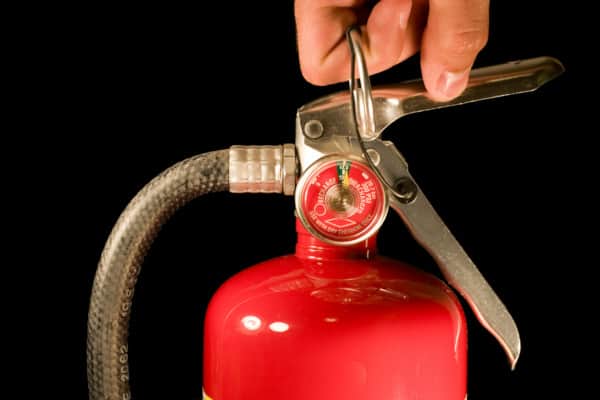Common-sense guidelines for selecting and purchasing home fire extinguishers protect today’s fire-prone residences
Every 88 seconds, a home somewhere in the United States catches fire. But while the vast majority of commercial and industrial spaces have fire protection systems ranging from fire sprinklers to sophisticated fire alarms, many family homes don’t even have a working fire extinguisher.
In this guide, we provide an overview of home fire extinguishers, briefly explaining their place in home fire safety before turning to extinguisher types, sizes, ratings, and other key recommendations for their selection and strategic placement.
Need to get a hold of a home fire extinguisher now? Take a look at our selection of multipurpose ABC dry chemical extinguishers in a variety of sizes.
Home fire extinguishers are an important part of a complete fire safety strategy
Fire departments respond to more than 350,000 home fires each year. And leading fire and safety organizations report that today’s homes—made with more flammable synthetic materials and furnishings—burn much faster than homes built decades ago.
Experts at the National Fire Prevention Association (NFPA) have found that nearly half of residential fires are caused by cooking equipment. 60 percent of those fires start at ranges and cooktops, particularly at Thanksgiving, Christmas, and Super Bowl Sunday. However, not all fires stem from the kitchen: heating equipment, along with wiring, outlets, switches, and cords, start nearly a quarter of other fires.
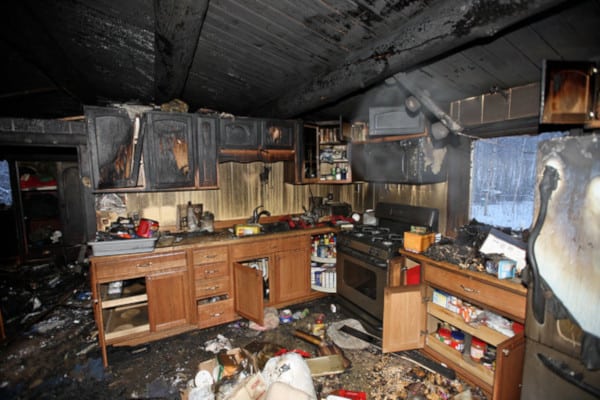
Home fire extinguishers can stop fires like these before they get out of hand. Portable extinguishers have an impressive track record, putting out 95% of the fires in which they were used. But just having one isn’t enough. A 2012 study from the Worchester Polytechnic Institute suggests that while most people can successfully use a fire extinguisher, the majority of individuals struggle to remove the pin during their first use. Hands-on training can significantly decrease the time to discharge—and the time the fire has to spread.
While they’re effective and easy to use, no family should rely exclusively on home fire extinguishers. Each home should have a fire escape plan that provides at least two ways out of every room. Doors and windows leading to an escape route should open easily. Smoke alarms should be properly maintained and interconnected. And while only a handful of American homes have them, residential fire sprinklers can make homes much, much safer. Studies have found that residential fire sprinklers reduce civilian and firefighter deaths by roughly 80 percent, and significantly reduce property damage.
Multipurpose dry chemical fire extinguishers perform better than CO2 extinguishers against the most common house fires
We’ve taken a close look at the need-to-know characteristics of fire extinguishers in our “Ultimate Guide to Fire Extinguisher Classes: Servicing and Use.” It’s worth a read—especially for those who haven’t bought an extinguisher before—but one key takeaway is this: different kinds of fires need different extinguishers.
Most consumer-grade fire extinguishers stop fires with either a multipurpose dry chemical or carbon dioxide (CO2). In the home, it’s multipurpose dry chemical fire extinguishers that have the biggest benefits. These extinguishers stop heat-generating chemical reactions in fires and deprive them of oxygen, allowing them to extinguish three common types of fire:
- Class A fires, which burn wood, trash, and other “ordinary combustibles”
- Class B fires made from flammable liquids and gases, like gasoline, propane, and paint
- Class C fires, which start from energized electrical equipment and burn Class A or B materials
CO2 fire extinguishers, on the other hand, don’t perform well against Class A fires. These BC-rated home fire extinguishers deprive fires of access to oxygen. That makes them especially useful against electrical fires—which they can extinguish with no residue or damage—and good against burning liquids. But they’re not effective against a burning couch or drywall, which may smolder and reignite. Watch a BC-rated extinguisher fail to put out a small cardboard fire in the video below:
Unsurprisingly, fire protection experts who spoke with the product review website Wirecutter unanimously recommended home fire extinguishers made for all three fire classes (ABC-rated extinguishers). They’re effective against a wide range of fires and, unlike some other extinguishers, don’t run the risk of making a fire worse.
Proper placement of home fire extinguishers accounts for distance and known hazards
In commercial, industrial, and large residential buildings, fire code provides building owners with a clear sense of when and where extinguishers should be installed. Fire extinguishers belong in an easy-to-see and easy-to-reach location with the label in plain view. The building’s size and the severity of the fire hazards within it dictate how far away an extinguisher can be at any given time—as well as the type and size of those extinguishers.
These strict guidelines don’t apply in single-family homes, but the same basic principles can help homeowners and renters choose a suitable location for an extinguisher. Most homes could be considered a “light hazard” occupancy—a term used by the NFPA to describe offices, churches, schools, and other spaces with few flammable materials. Buildings like these require an extinguisher with an A rating no further than 75 feet away in any location with wood, trash, and other Class A materials. Anywhere there are flammable liquids or other Class B hazards, a B-rated extinguisher should be nearby—somewhere between 30 to 50 feet away depending on the extinguisher’s size.
More than half of home fires start in kitchens, bedrooms, chimneys, and living rooms. As such, a number of fire protection officials recommend tailoring placement and selection to a home’s specific hazards. Vince Palandri, a firefighter with the Payson Fire Department in Payson, Arizona, recommends placing home fire extinguishers in locations where a fire is most likely or particularly hazardous, including:
- Bedrooms
- Kitchens
- Furnace areas
- Garages and workshops
Each floor should have at least one fire extinguisher. Those extinguishers should be placed close to an exit so that the user can escape if the fire can’t be controlled. And they should be easy to find and reach. Don’t store them somewhere obscure (like the back of a closet) or where fire may break out (such as over a stove).
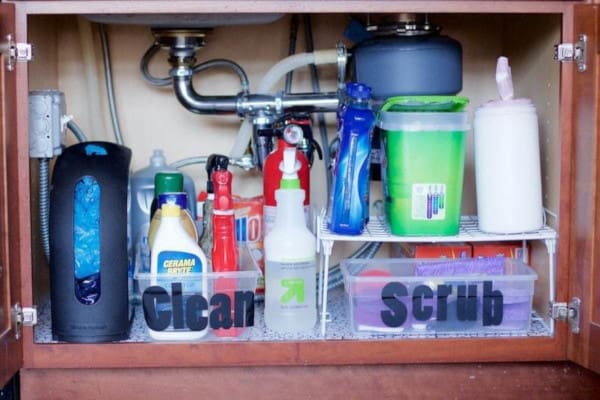
Classifications or UL ratings provide a measure of home extinguishers’ firefighting ability
The label of each home fire extinguisher carries a UL rating. This series of numbers and letters indicates which classes of fires the extinguisher can fight—and how much firefighting power it contains.
Each letter refers to a fire class. A “1A” home fire extinguisher can fight Class A fires, a “5B” extinguisher can fight Class B fires, and a “C” extinguisher can fight class C fires. For each number before an “A”, that extinguisher contains the firefighting equivalent of 1.25 gallons of water. Therefore, each 1A extinguisher has the power of 1.25 gallons of water, a 2A extinguisher has 2.5 gallons’ worth, and so on.
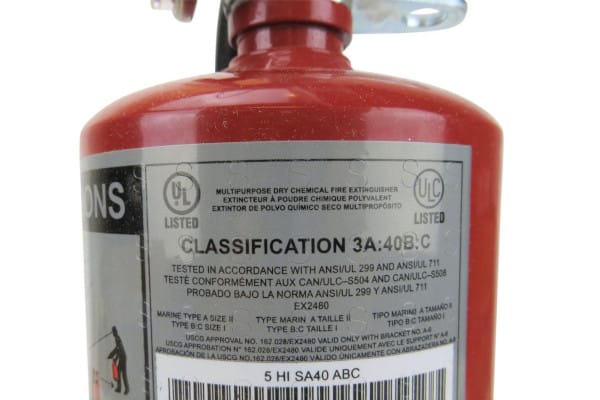
The “B” number indicates the size, in square feet, of Class B fire that the extinguisher can put out. The “40B” extinguisher pictured below can extinguish 40 square feet of fire. Finally, the letter “C” doesn’t have a number. While only some types of extinguisher can safely fight electrical fires, all electrical fires ultimately burn other materials—and it’s those materials that the extinguisher puts out.
Five-pound home fire extinguishers work well in most cases, while ten-pound extinguishers offer more power when needed
In non-residential settings, 2A:5B extinguishers provide the minimum acceptable level of protection in environments with both Class A and Class B fires. That size makes 5-pound dry chemical extinguishers—rated from 2A:10B:C to 3A:40B:C—the go-to recommendation in most locations throughout the home. These lightweight extinguishers strike a balance between firefighting power and ease of use, making them ideal for use in kitchens, laundry rooms, and bedrooms.
Higher-risk environments, like garages and furnace rooms, may be better served by 10-pound dry chemical ABC extinguishers. With ratings from 1A:20B:C to 4A:80B:C, these heavy-duty extinguishers are useful where fires may have time to grow or may more readily increase in size.
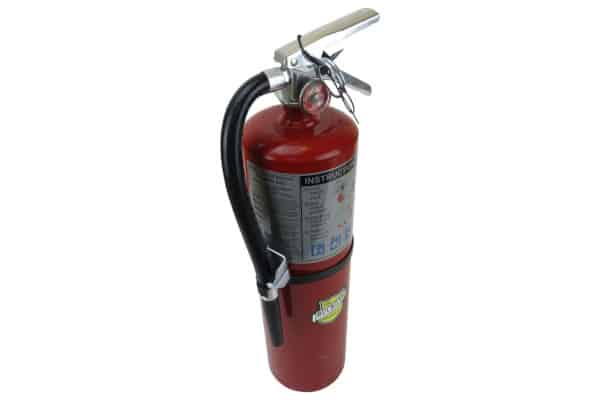
QRFS carries a selection of fire extinguishers from Buckeye, a North Carolina-based manufacturer. Their product line features a range of dry chemical fire extinguishers, including 3A:40B:C extinguishers and 4A:80B:C extinguishers, ideal for use throughout the home. These rechargeable extinguishers can be refilled after use or when depleted, saving money over their lifetime. Each includes a wall bracket for safe and visible mounting in the home.
Browse our selection of UL and ULC-listed dry chemical ABC fire extinguishers from Buckeye.
If you have any questions about purchasing a home fire extinguisher, call us at +1 (888) 361-6662 or email support@qrfs.com.
This blog was originally posted at blog.qrfs.com. If this article helped you get a better understanding of home fire extinguishers, check us out at Facebook.com/QuickResponseFireSupply or on Twitter @QuickResponseFS.


